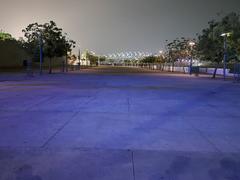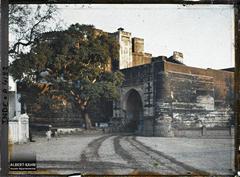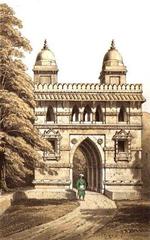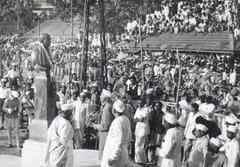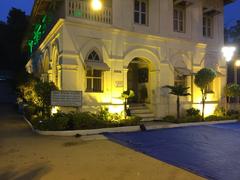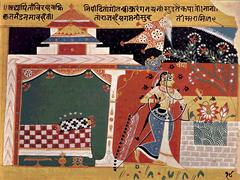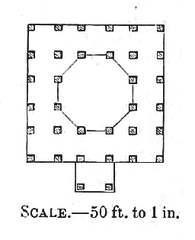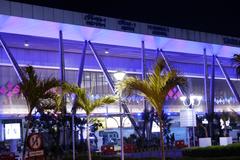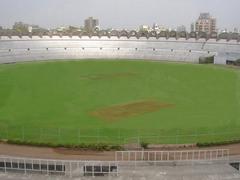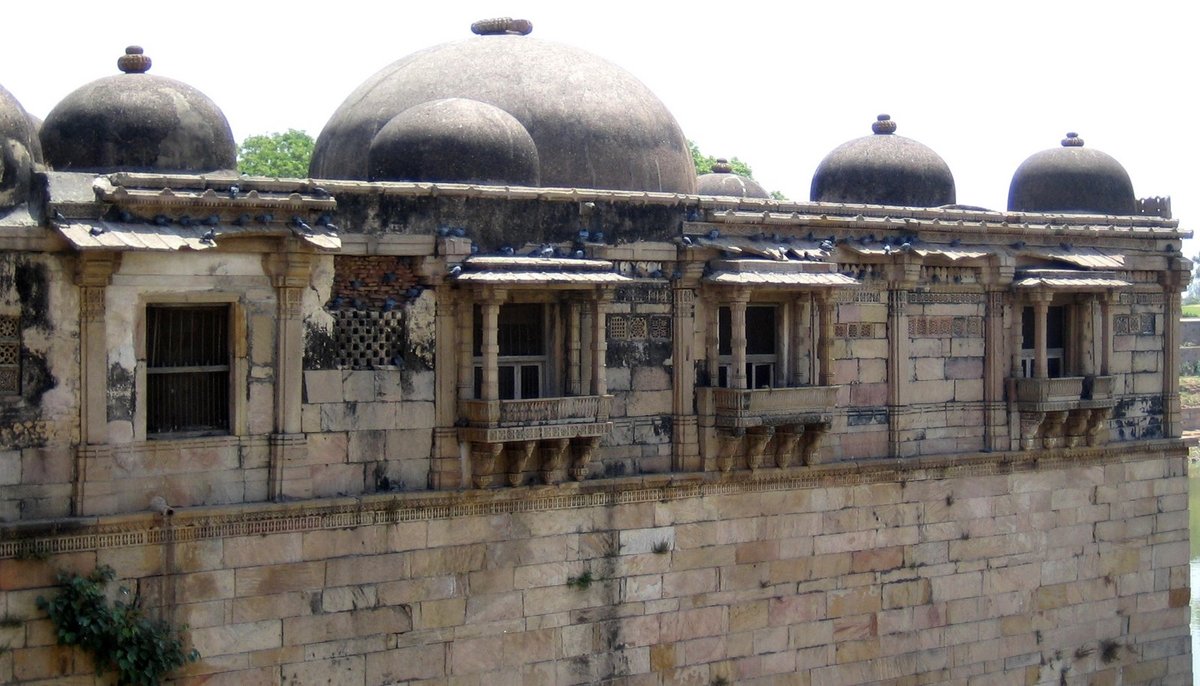
Sarkhej Roza Visiting Hours, Tickets, and Historical Significance
Date: 31/07/2024
Introduction
Sarkhej Roza is a historical and architectural gem located in Makarba village, approximately 7 kilometers southwest of Ahmedabad, Gujarat. This complex is a remarkable blend of spirituality and artistry, making it an essential destination for visitors interested in India’s rich cultural heritage. The origins of Sarkhej Roza date back to the 15th century when it was established as a retreat for the revered Sufi saint, Shaikh Ahmed Khattu Ganj Baksh. Over time, it has evolved into a monumental complex featuring a mosque, mausoleum, palaces, and a large tank, collectively reflecting a fusion of Persian and indigenous architectural styles (CN Traveller, Wikipedia).
The architectural style of Sarkhej Roza is a precursor to the Indo-Saracenic architecture of the Mughal period, characterized by the integration of Islamic geometric principles with Hindu and Jain craftsmanship. This unique blend is credited to two Persian architects, Azam and Muazzam Khan, who contributed significantly to the complex’s design. The site has garnered attention not only for its historical significance but also for its serene environment, making it a center of Sufi culture in India (Travel Setu, Sarkhej Roza Official Site).
Visitors to Sarkhej Roza can explore its various structures, including the Jama Masjid, the mausoleum of Shaikh Ahmed Khattu Ganj Baksh, and several palaces and pavilions. The complex also features a sophisticated rainwater harvesting system and intricate architectural details that offer a glimpse into the early Islamic architectural culture in India. With its rich history and cultural significance, Sarkhej Roza provides a profound and enriching experience for all who visit.
Table of Contents
- Introduction
- Historical Background of Sarkhej Roza
- Architectural Significance
- Cultural and Spiritual Significance
- Preservation and Tourism
- Visitor Information
- FAQ
- Conclusion
Historical Background of Sarkhej Roza
Origins and Early Development
Sarkhej Roza’s origins date back to the 15th century when it was initially established as a retreat for the revered Sufi saint, Shaikh Ahmed Khattu Ganj Baksh. The saint, originally from Delhi, settled in Sarkhej and became a prominent spiritual figure in the region. His close association with Sultan Ahmed Shah, the founder of Ahmedabad, played a crucial role in the development of the complex (CN Traveller).
Construction and Expansion
Following the death of Shaikh Ahmed Khattu Ganj Baksh in 1445, Sultan Ahmed Shah ordered the construction of a mosque and mausoleum in his memory. However, the completion of these structures occurred under the reign of his successor, Sultan Qutb’ud-Din Ahmed Shah. The initial construction marked the beginning of a series of monuments that would integrate spiritual, royal, and social elements, setting the foundation for the complex’s future expansion (Wikipedia).
The complex saw significant expansion under Sultan Mahmud Begada, who transformed it into a colossal architectural marvel. This expansion included the addition of a mosque, tombs, palaces, and a large tank known as Ahmed Sar, developed on the southern and western banks of the complex. The architectural style of Sarkhej Roza is a blend of Persian influences and indigenous craftsmanship, exemplifying the early Islamic architectural culture in India (Travel Setu).
Architectural Significance
Sarkhej Roza is renowned for its unique architectural style, which is a precursor to the Mughal period’s Indo-Saracenic architecture. This style is characterized by the fusion of Islamic geometric and scale principles with Hindu and Jain craftsmanship. The complex’s architecture is credited to two Persian brothers, Azam and Muazzam Khan, who are also buried within the complex. The original complex spanned over 72 acres, surrounded by elaborate gardens, although human settlements have since reduced this area to 34 acres (Sarkhej Roza Official Site).
Key Structures within the Complex
The Mosque and Mausoleum
The mosque, also known as the Jama Masjid, is an elegant structure spread over an area of 4300 square yards. It features a rainwater harvesting system designed to collect and utilize rainwater during the dry season. The mausoleum, or dargah, of Shaikh Ahmed Khattu Ganj Baksh is the largest in Gujarat, standing at a height of 105 feet. The dargah also houses the tombs of the saint’s disciples, including his spiritual heir, Sheikh Salahuddin (Ahmedabad Tourism).
The Palace and Pavilions
The complex includes several palaces and pavilions, which were added during the reign of Sultan Mahmud Begada. These structures were designed to provide a serene environment for reflection and spirituality. The Bardari, located in the center of the open courtyard, is an elegant structure with nine domes supported by sixteen pillars. Although it was damaged during the 2001 earthquake, it has since been restored by the Archaeological Survey of India (Travel Setu).
Cultural and Spiritual Significance
Sarkhej Roza has long been a center of Sufi culture in India. The complex’s serene environment and spiritual significance have attracted travelers and devotees for centuries. The site is often referred to as the “Acropolis of Ahmedabad,” a term coined by the famous French architect Le Corbusier during his visit in the 1950s. This comparison highlights the complex’s architectural grandeur and historical importance (CN Traveller).
Preservation and Tourism
Efforts are ongoing to preserve and promote Sarkhej Roza as a significant cultural and historical site. The Sarkhej Roza Committee, which maintains the complex, has been working to improve visitor facilities, including sanitation and informational materials. Despite these efforts, there is still a need for more comprehensive information in both English and vernacular languages to enhance the visitor experience (Sarkhej Roza Official Site).
Visitor Information
Sarkhej Roza is open to visitors from 9 am to 6 pm daily. Visitors are expected to maintain the sanctity of the site by removing their footwear and covering their heads before entering the holy areas. The complex is accessible via various modes of transportation, including local buses, taxis, and private cabs. The nearest railway station is Kalupur, located 11 kilometers from the site, and the Sardar Vallabhbhai Patel International Airport is also within easy reach (Ahmedabad Tourism).
Ticket Prices and Travel Tips
There is no entry fee for visiting Sarkhej Roza, making it an accessible attraction for all. However, donations towards the upkeep of the site are appreciated. When planning your visit, consider hiring a local guide for a more insightful experience. The best time to visit is during the cooler months from October to March. Nearby attractions include the Sabarmati Ashram and the Calico Museum of Textiles, which are worth exploring to enhance your cultural journey.
FAQ
Q: What are the visiting hours for Sarkhej Roza?
A: Sarkhej Roza is open to visitors from 9 am to 6 pm daily.
Q: Is there an entry fee for Sarkhej Roza?
A: No, there is no entry fee, but donations are appreciated.
Q: What is the best time to visit Sarkhej Roza?
A: The best time to visit is during the cooler months from October to March.
Q: Are there guided tours available?
A: Yes, hiring a local guide is recommended for a more insightful experience.
Q: What are some nearby attractions?
A: Nearby attractions include the Sabarmati Ashram and the Calico Museum of Textiles.
Conclusion
Sarkhej Roza stands as a testament to the rich cultural and architectural heritage of Ahmedabad. Its historical significance, combined with its unique architectural style, makes it a must-visit destination for those interested in exploring the confluence of spirituality and artistry in India. The ongoing preservation efforts and the site’s accessibility ensure that visitors can continue to experience the serenity and grandeur of this remarkable complex. Whether you are a history enthusiast, an architecture aficionado, or simply looking to explore the rich cultural heritage of Gujarat, Sarkhej Roza provides a memorable and enlightening experience. For more updates and travel tips, follow us on social media or download our app (CN Traveller, Ahmedabad Tourism).
References
- Sarkhej Roza, CN Traveller https://www.cntraveller.in/story/sarkhej-roza-gujarat-the-story-behind-monuments-of-india/
- Sarkhej Roza, Wikipedia https://en.wikipedia.org/wiki/Sarkhej_Roza
- Sarkhej Roza Tourism History, Travel Setu https://travelsetu.com/guide/sarkhej-roza-tourism/sarkhej-roza-tourism-history
- Sarkhej Roza History, Sarkhej Roza Official Site https://www.sarkhejroza.org/history.html
- Sarkhej Roza, Ahmedabad Tourism https://ahmedabadtourism.in/sarkhej-roza-ahmedabad


